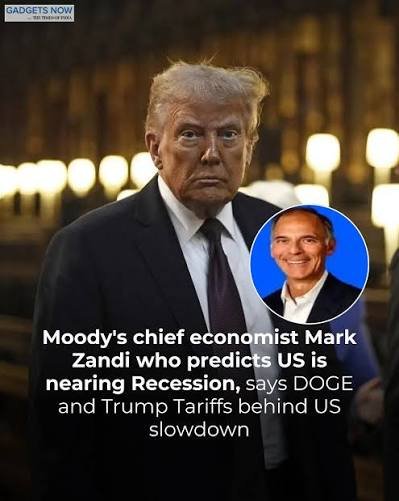Moody’s chief economist Mark Zandi who predicts US is nearing Recession, says DOGE and Trump Tariffs behind US slowdown
Mark Zandi is chief economist at Moody’s Analytics. His work focuses on macroeconomic trends, fiscal and monetary policy, forecasting, etc.
He has in recent months been increasingly vocal warning that the U.S. economy is “on the precipice” of a recession.
What He Says: Recession Risk is High
Zandi argues that a number of U.S. states, together accounting for about one-third of U.S. GDP, are either already in recession or “high risk” of recession. Another third are flat/slowing; the remaining third are still growing.
He doesn’t say we are definitely in a recession as of now (by conventional definitions), but that many industries (manufacturing, construction, etc.) are contracting and job growth is weakening.
Inflation remains elevated; consumer purchasing power is under pressure. Business investment and hiring have been delayed because of policy uncertainty.
Key Drivers According to Zandi.
Zandi places considerable blame on certain policy decisions and external / speculative pressures. In particular:
1. Tariffs (Trump-era trade policy)
Tariffs are “substantive,” he says; even if their full effects haven’t all shown up yet, many are being passed through progressively into prices for consumers.
Tariffs are hurting company profits and eroding household purchasing power. Higher input costs, disrupted supply chains, uncertainties for businesses making investment decisions.
2. Restrictive immigration policies
Zandi argues that limiting immigration (or tightening immigration) reduces labor supply, which in turn constrains growth. Businesses have less flexibility; sectors that rely on immigrant labor see impact.
3. “DOGE” (Note: this appears to be not Dogecoin, but “Department of Government Efficiency” – an office in the federal government executing job cuts)
This is a bit confusing in many media reports, because “DOGE” might sound like the meme coin, but Zandi’s references (in sources like Quartz) show that “DOGE” is an acronym for a federal office tasked with cutting government jobs / reducing federal spending (“Department of Government Efficiency”).
According to Zandi, cuts in the federal workforce via DOGE are already taking effect in certain areas, contributing to weakening government employment, especially around the Washington, D.C. area. These contribute to lower aggregate demand and reduce employment in government sectors.
4. Federal Reserve / Monetary Policy & Inflation
High inflation and elevated interest rates are making borrowing costlier. Rate cuts may be in the works (or anticipated), but Zandi believes they may only “cushion” the slowdown, not stop it.
Because inflation is still above the Fed’s target, and because tariffs push input / consumer goods prices higher, the inflationary impulse is not yet dissipated.
5. Policy Uncertainty
Because of the interactions of trade/tariff policies, immigration, labor rules, etc., businesses are hesitating: delaying investment or hiring. Uncertainty tends to reduce economic momentum even before a formal recession begins.
Assessing the Evidence: Strengths & Weaknesses
Strengths:
Zandi uses granular, state-level data which gives early signs of economic divergence across U.S. states. Some states appear already under stress.
He tracks multiple indicators: employment (including government employment), industrial production, household employment, construction/manufacturing contraction, etc. This multi-pronged approach increases credibility.
His argument that tariffs and restrictive policies feed into inflation and reduced purchasing power is plausible, and many independent economists also warn of similar effects.
Weaknesses / Uncertainties:
Timing is fuzzy: when exactly will a recession (if it comes) begin? How deep will it be? Zandi acknowledges he can’t precisely forecast that.
Some of the policy effects are lagged: tariffs often take time to percolate through prices and supply chains; labor market responses don’t shift instantly. So some of the damage may not yet be seen, but also might be mitigated.
External shocks are possible (positive or negative) that could alter the path: e.g. energy prices, geopolitical events, or tightening/loosening of trade relations.
The definition of recession is conventional (2 consecutive quarters of GDP decline), but many of these signs are partial or sector-based; some states or sectors may already be in decline, others still growing—so the US could have a “patchy” slowdown rather than uniform recession.
Implications
For households: inflation (especially on consumer goods, imported items) will put pressure on real incomes; job stability could be threatened in vulnerable states or sectors. Government job cuts magnify risk.
For businesses: uncertainty around trade and cost structure (tariffs, immigrant labor) will likely lead to deferred investment, hiring. Firms that rely on imported inputs or cross-border supply chains are especially at risk.
For financial markets / investors: Safe havens might be sought; but Zandi warns even traditional “safe” assets (US Treasurys, the dollar) could come under stress if policy missteps continue. Tariffs could erode confidence.
What to Watch: Key Indicators & Policy Moves
To monitor whether the risks are materializing (or being mitigated), keep an eye on:
Indicator What to Watch For
Labor market Payroll additions / losses; unemployment rate; revisions of job data; whether aggregate employment starts declining.
Inflation & consumer prices Especially on goods affected by tariffs; core inflation vs headline inflation; real wage growth.
Business investment & industrial production Are factories cutting back? Is construction contracting further? Manufacturing PMI, capacity utilization.
State-level GDP / employment data To see whether stress is limited to some states or becoming more widespread.
Federal policy shifts Changes in trade/tariff policies, immigration policy, DOGE / federal job cuts; Fed rate‐cuts or guidance.
Consumer spending Since consumer demand contributes large share of U.S. growth, weakness here is a strong signal.
Conclusion & My Take
Zandi’s warning is worth taking seriously. The confluence of several policy headwinds (tariffs, restrictive immigration, government job cuts) alongside macroeconomic pressures (inflation, rate tightening) suggests the risk of recession is non-trivial.
www.startupstreets.com, www.growmoreloans.com, www.growmorefranchisees.com, www.intellexcfo.com

